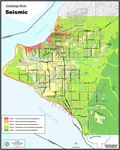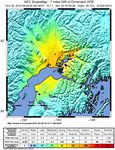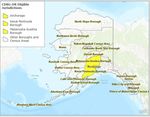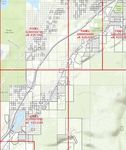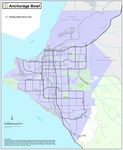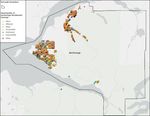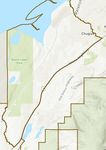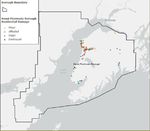STATE OF ALASKA PLAN FOR DISASTER RECOVERY #4413
←
→
Page content transcription
If your browser does not render page correctly, please read the page content below
STATE OF ALASKA
PLAN FOR DISASTER
RECOVERY #4413:
2018 Cook Inlet Earthquake
(POINT MACKENZIE EARTHQUAKE)
Substantial Amendment #1
Abstract
The Supplemental Appropriations for Disaster Requirements (Pub. L. 116-20)
approved June 6, 2019
December 16, 2020July 30, 2021
Michael Dunleavy, Julie Anderson, Sandra Moller,
Governor Commissioner Director
State of Alaska Department of Commerce, Division of Community and
Community, and Economic Regional Affairs
DevelopmentSubstantial Amendment #1 is a partial Action Plan, which adds additional references and amends Introduction and Background on pages 5-9; Impact and Unmet Needs Assessment on pages 10-58; revises the Proposed CDBG-DR Budget on pages 39-41 and Appendix A; temporarily deletes the Public Housing, Homeowner’s Reimbursement, Local Buyout, and Public Infrastructure Programs; permanently deletes the Temporary Relocation Assistance and the Manufactured Home Repair or Replacement Programs; and adds the Forest Park Optional Relocation Program on pages 66-70. Due to the severity of the Unmet (Affordable) Housing Needs within the Municipality of Anchorage and the Matanuska-Susitna Borough, the Public Infrastructure Programs within the Municipality of Anchorage and the Matanuska-Susitna Borough, and the entire Economic Revitalization Program have been deleted. Substantial Amendment #1 proposes limited funding use of $2.5M for the purpose of expediting one program activity, the Forest Park Optional Relocation Program, within the Municipality of Anchorage, the HUD designated “Most Impacted and Distressed (MID)” jurisdiction and $7,171,200 for State Administration and Planning funds so the State may continue to work with the jurisdictions to identify capacity and prioritize housing and program activities. Substantial Amendment #2 will be posted by August 31, 2021 for the remaining proposed program activities, totaling $26,184,800. The State of Alaska, Department of Commerce, Community, and Economic Development (DCCED), complies with Title II of the Americans with Disabilities Act of 1990. This publication is available in alternative communication formats upon request. Please contact the DCRA publication Specialist at 1- 907-269-4560 or DCRA.publications@alaska.gov to make any necessary arrangements. The Alaska Relay is 711 or 1-800-770-8973\TTY, 1- 800-770-8255\Voice.
Table of Contents
I. Introduction and Background ............................................................................................................. 5
II. General Action Plan Requirements ................................................................................................... 10
A. Impact and Unmet Needs Assessment ..................................................................................... 10
1. Housing ................................................................................................................................ 12
2. Public Infrastructure ............................................................................................................ 25
3. Economy............................................................................................................................... 27
4. Post-Earthquake Financial Assistance for Home-Owners & Business-Owners .................. 31
5. Summary of Unmet Needs and Allocation of Funds & Proposed Budget ........................... 39
6. Rehabilitation/Reconstruction of Public Housing, Affordable Housing and other forms of
Assisted Housing .................................................................................................................. 42
7. Housing for Vulnerable Populations .................................................................................... 43
8. Minimizing Displacement and Ensuring Accessibility .......................................................... 43
9. Maximum Assistance & Reasonable Cost Assurance .......................................................... 45
10. Planning and Coordination ................................................................................................... 46
11. Floodplains, Wetlands, Coastal/Riverine Bluffs, Landslides & Seismic Hazard .......................
Zones 4 & 5 ........................................................................................................................... 48
12. Protection of People and Property ...................................................................................... 51
13. Public Infrastructure Activities ............................................................................................. 55
14. Resilience to Natural Hazards .............................................................................................. 55
15. Disaster Recovery and Response Plan .................................................................................. 56
16. Leveraging Funds .................................................................................................................. 57
17. Construction Standards ........................................................................................................ 57
B. Projects and Activities ............................................................................................................... 59
1. Overview .............................................................................................................................. 59
2. Basis for Allocations ............................................................................................................. 59
3. DCCED Use of Funds ............................................................................................................. 59
III. Citizen Participation – State Action Plan .......................................................................................... 74
A. Publication ................................................................................................................................ 74
B. Consideration of Public Comments .......................................................................................... 75
C. Citizen Complaints .................................................................................................................... 75
D. Substantial Amendment ........................................................................................................... 75
E. Non-Substantial Amendment ................................................................................................... 76
F. Community Consultation .......................................................................................................... 76
G. Public Website .......................................................................................................................... 76
Page 3 of 96H. Waivers ..................................................................................................................................... 77
IV. References ........................................................................................................................................ 78
V. Appendix A - Budget ......................................................................................................................... 82
Appendix B - FEMA Region X, Post-Earthquake Recommendations For Mitigation……………………...83
Appendix C - Birchwood/Chugiak Disaster Recovery Area……………………………………………………………89
Appendix D - Summary of Public Comments……….……………………………………………………………………….93
Page 4 of 96I. Introduction and Background Since January 2011, FEMA Region X has partnered with the State of Alaska to deploy Risk Mapping, Assessment, and Planning, (Risk MAP) projects with the goal of accurately and comprehensively depicting natural hazard risks throughout Alaska, including the Municipality of Anchorage, the Matanuska-Susitna Borough, and the Kenai Peninsula Borough. In September 2018, FEMA published the draft Risk Report for the Municipality of Anchorage (Reference 1), which included a M7.2 Intraplate Earthquake scenario (very similar in type, intensity and proximity to the actual M7.1 2018 Cook Inlet Earthquake) with an Estimated Total Dollar Loss of $458.2 million within the Municipality of Anchorage, which included $9.4M in Chugiak and $25M in Eagle River. FEMA Region X, the State of Alaska, and the Municipality of Anchorage are scheduled to resumed the Risk MAP project in January 2021 with a presentation by review of the Earthquake Engineering Research Institute’s on its Reconnaissance Report (Reference 2), which formally documented observed impacts of the 2018 Cook Inlet Earthquake. The following information was extracted and summarized from Governor Michael J. Dunleavy, “Request for Major Disaster Declaration, January 3, 2019”, State of Alaska Letter, Available: https://gov.alaska.gov/wp-content/uploads/sites/2/Request-for-Presidential-Disaster- Declaration.pdf. (Reference 1 3) On November 30, 2018, at 8:29 am, Alaska Standard Time, a 7.1 magnitude earthquake located seven miles north of Anchorage near Point MacKenzie produced very strong seismic shaking that caused widespread and severe damage primarily within the Municipality of Anchorage, the Matanuska-Susitna Borough, and the Kenai Peninsula Borough. (References 2 4-6) The earthquake, and the subsequent aftershocks, caused damage to major highways and important public roads, bridges, and other transportation infrastructure; undermining of road embankments and railroad tracks, and loss of track base; widespread power, water, and communication disruption; structural collapse and resulting fires to several buildings; and severe damage to private homes, personal property, and businesses. There were no fatalities during the 2018 Cook Inlet Earthquake and thus far, there have been no earthquake-related fatalities during the recovery. However, there is an urgent need to respond to the residents still living in a privately owned mobile home park, where the community water well and potable water distribution system was further damaged during the 2018 Cook Inlet Earthquake. Lives depend upon CDBG-DR funds being approved. In order to adequately plan and prepare for the next construction season beginning in April 2021, it is imperative for this Action Plan and the Implementation Plan be reviewed and approved in an expedient manner. Page 5 of 96
Figure 1 The concentration of the shaking was primarily limited to three jurisdictions; the Municipality of Anchorage, the Matanuska-Susitna Borough, and the Kenai Peninsula Borough, which are represented in Figure 2. During the following two years, nearly 10,000 over 12,000 aftershocks were recorded by USGS. Significant seismic activity continues in this area as evidenced by the most recent 5.1 4.8 magnitude earthquake on November 8, 2020 April 27, 2021. Page 6 of 96
These conditions required local emergency protective measures to protect life and property, including activation of emergency operation centers, emergency debris clearance and temporary repairs to highways, public roads, and railroad tracks to protect critical infrastructure and maintain access, placement of road barricades to protect roads and bridges, operation of mass shelters for affected residents, and school, business and government office closures. All affected communities are located around Cook Inlet in Southcentral Alaska. The Municipality of Anchorage is the largest metropolitan area in the State of Alaska with a 2018 population of 295,365. The Matanuska-Susitna Borough is located approximately 30 miles north of Anchorage, encompasses 24,682 square miles (slightly larger than the State of West Virginia) and in 2018 had a population 105,743. The Kenai Peninsula Borough is located across the Turnagain Arm, about 40 miles south of Anchorage and in 2018 had a population of 58,471. (Reference 4 8) The three contiguous jurisdictions affected by the earthquake comprise over 60 percent of the State's total population and a substantial portion of Alaska's economic base. Figure 2 The National Weather Service (NWS) National Tsunami Warning Center (NTWC) issued a tsunami warning for the Cook Inlet, including the Municipality of Anchorage, the Matanuska-Susitna Borough and the southern Kenai Peninsula Borough within minutes of the earthquake. Page 7 of 96
The Municipality of Anchorage is the predominant economic center of the State, and is comprised of the City of Anchorage, and suburban areas to the north and south. The 2010 Census found a population of 34,982 in Eagle River and smaller settlements further north of Anchorage -- Chugiak, Birchwood, Peters Creek, Thunderbird Falls, and Eklutna, an Alaska Native village of about 70 residents. These communities were annexed into the Municipality of Anchorage in 1975 and remain major suburban centers. The search for affordable housing and property encouraged Anchorage residents to move further north to the cities of Palmer, Wasilla, Houston, Sutton, and other communities of the Matanuska-Susitna Borough. Over 52,000 vehicles use the Glenn Highway that connects Anchorage and the Matanuska-Susitna Borough every day, serving commuters, visitors and commercial traffic. Immediately following the earthquake, the State of Alaska activated the Emergency Operations Plan (EOP) and staffed the State Emergency Operations Center (SEOC) to Level three (actual event). The Municipality of Anchorage and the Matanuska-Susitna Borough each activated their EOCs to coordinate the response and all three jurisdictions declared local states of emergency. Due to the scope of the earthquake damage and associated response efforts, Governor Walker verbally declared a State Disaster Emergency for the Municipality of Anchorage, the Matanuska- Susitna Borough, and the Kenai Peninsula Borough on November 30, 2018. This verbal declaration was followed by an official written declaration on December 2, 2018. This declaration authorized funds be made available from the State’s public assistance, individual assistance, and temporary housing assistance programs, as well as, necessary administrative and disaster management expenses. The cost and scope of the disaster was sufficient to warrant immediate federal disaster assistance; thus, in consultation with the Federal Emergency Management Agency (FEMA), Governor Walker requested and received an Emergency Declaration (EM-3410-AK) for direct federal assistance on November 30, 2018. On January 3, 2019, under the provisions of Section 401 of the Robert T. Stafford Disaster Relief and Emergency Assistance Act, 42 U.S.C. 5121-5207 (Stafford Act) and implemented by 44 CFR 206.36, Governor Dunleavy requested a Declaration of Major Disaster for the State of Alaska to include the full suite of individual and public assistance, and temporary housing programs, as well as, necessary administrative and disaster management expenses, for the State of Alaska as a result of a major earthquake on November 30, 2018. He specifically requested supplemental federal disaster assistance programs available under the Individual and Households Program, Disaster Legal Services, Disaster Unemployment Assistance, Disaster Case Management, and Crisis Counseling Program. Governor Dunleavy also requested an Agency Declaration from the U.S. Small Business Administration (SBA), which was critical to the initial recovery. The Presidential declaration of a major disaster for the State of Alaska (FEMA-4413-DR) was issued on January 31, 2019, which authorized $28,052,842.61 in Individual & Households Program; $27,717,950.97 in Housing Assistance; $334,891.64 for Other Needs Assistance; and $1,144,688 for the Hazard Mitigation Grant Program. (Reference 5 9) Page 8 of 96
In the Federal Register notice published on January 27, 2020 at 85 FR 4681, the State of Alaska received an allocation of $35,856,000 from the U.S. Housing and Urban Development (HUD) under Public Law 116-20 for FEMA Disaster No. 4413, the 2018 Cook Inlet Earthquake. (Reference 6 10) HUD identified the Municipality of Anchorage, the Matanuska-Susitna Borough, and the Kenai Peninsula Borough as the only Community Development Block Grant-Disaster Recovery (CDBG-DR) eligible jurisdictions, in their entirety, and identified the Municipality of Anchorage as the “most impacted and distressed” area, which will receive 80% of the funding. The State of Alaska has a FEMA approved Hazard Mitigation Plan. (Reference 7 11) The Municipality of Anchorage also has a FEMA approved All Hazards Mitigation Plan, which is under revision. (Reference 8 12) On August 20, 2020, FEMA preliminarily On March 21, 2021, FEMA approved the Matanuska-Susitna Borough Hazard Mitigation Plan, which was scheduled for a public hearing on December 7, 2020. (Reference 9 13) The Kenai Peninsula Borough is finalizing finalized their Multi- Jurisdictional Hazard Mitigation Plan, which was approved by FEMA on December 18, 2019. (Reference 14) The State of Alaska has developed the CDBG-DR #4413, the 2018 Cook Inlet Earthquake, Action Plan as described in the Federal Register notices published on February 9, 2018 at 83 FR 5844, August 14, 2018 at 83 FR 40314, February 19, 2019 at 84 FR 4836, June 20, 2019 at 84 FR 28836 and 28848, August 14, 2020 at 85 FR 50041, and September 28, 2020 at 85 FR 60821 (References 10-16 15-21) and the guidelines set forth by the U.S. Department of Housing and Urban Development (HUD) for the Community Development Block Grant-Disaster Recovery Program. This Action Plan is in alignment with the State of Alaska Hazard Mitigation Plan 2018 prepared and maintained by the Department of Military and Veterans Affairs/Division of Homeland Security and Emergency Management (DMVA/DHS&EM). Upon receipt of additional guidance from FEMA Region X and HUD in 2021, DCCED will amend this Action Plan. This Action Plan is in alignment with the draft Alaska Housing Finance Corporation’s Consolidated Housing and Community Development Plan for the State of Alaska Five-Year Plan & Action Plan for State Fiscal Years 2021-2025 (Federal Fiscal Years 2020-2024), dated May 30, 2020, which was previously submitted to the U.S. Housing and Urban Development for the Community Development Block Grant Program. (Reference 17 22) The Municipality of Anchorage also has a Consolidated Housing and Community Development Plan for State Fiscal Years 2018-2022, dated October 4, 2018. The Municipality of Anchorage has two three amendments to their plan. The first amendment was unsubstantial and incorporated the Housing Trust Fund, dated June 3, 2019, and the second amendment was substantial, dated January 10, 2020. The third substantial amendment incorporated the CDBG-CV1 and ESG-CV1 and CV2 funds. (Reference 18 23) Page 9 of 96
II. General Action Plan Requirements
A. Impact and Unmet Needs Assessment
The State of Alaska/Department of Commerce, Community, and Economic Development (DCCED)
has completed the following Impact and Unmet Needs Assessment to evaluate the three core areas
of recovery – housing, infrastructure, and economic revitalization and plan disaster relief, recovery,
and mitigation activities within the three CDBG-DR eligible jurisdictions; the Municipality of
Anchorage, the Matanuska-Susitna Borough, and the Kenai Peninsula Borough.
The Needs Assessment of unmet housing needs addressed interim and permanent; owner and
rental; single family (1-4 dwelling units) and multi-family (5+ dwelling units); affordable, and market
rate; and housing to meet the needs of pre-earthquake homeless persons. Immediately after the
2018 Cook Inlet earthquake, the State of Alaska provided interim housing assistance. Currently,
there is no need for interim housing assistance. According to FEMA, as of May 8, 2019, there were
5,642 housing units with $4,110,952.80 in unmet housing need for all types of owner-occupied
housing. FEMA revised this estimate to 4,572 houses with a total of $10,258,920.82 ($12,823,651
including 25% resiliency factor) in unmet housing need. According to FEMA, as of May 8, 2019,
there was no remaining earthquake damage to affordable and market-rate rental units. According
to the Alaska Housing Finance Corporation, Alaska’s sole public housing authority, there is no
remaining earthquake damage to affordable public housing. According to the Cook Inlet Housing
Authority, there is no remaining earthquake damage to Indian (Alaska Native) housing. However,
there remains an unmet disaster relief need for 35 households residing in Chugiak, an unmet
housing need for the 1,000+ pre-earthquake homeless persons (the majority are in protected
classes), and a severe shortage of affordable housing (5,000+) within the Municipality of Anchorage.
The Needs Assessment considered the various forms of assistance available to, or likely to be
available to, the three CDBG-DR eligible jurisdictions for earthquake repairs, seismic and structural
analysis, as well as, seismic and structural upgrades to public infrastructure. Since the 2018 Cook
Inlet earthquake, the three CDBG-DR eligible jurisdictions; the Municipality of Anchorage, the
Matanuska-Susitna Borough, and the Kenai Peninsula Borough have been submitting requests for
reimbursement for repairs to earthquake-damaged public facilities through the State of Alaska to
FEMA. Most of the earthquake damage to public infrastructure within the three CDBG-DR eligible
jurisdictions has been addressed either through FEMA, the State of Alaska, or other sources.
Based on the information, as of May 8, 2019, provided by FEMA, the State of Alaska produced
estimates of Serious Unmet Housing Need, Serious Unmet Local Infrastructure Need, and Serious
Unmet Business Need by estimating the portion of need likely to be addressed by insurance
proceeds, other federal assistance, or any other funding source by using the most recent available
data. The State of Alaska/DCCED has the data set from the DMVA/DHS&EM (Department of Military
and Veteran Affairs/Division of Homeland Security and Emergency Management for the State of
Alaska’s Individual and Family Grant Program and Temporary Housing Program), FEMA, and the
SBA. The State of Alaska/DCCED has not contacted any of the applicants for the FEMA Individual
Assistance Program and the SBA Disaster Home Loan Program to determine if there is still an unmet
housing need within the three CDBG-DR eligible jurisdictions, especially within the Municipality of
Anchorage.
Page 10 of 96The Needs Assessment considered whether public services are necessary to complement activities intended to address housing. and economic revitalization. Temporary Housing, Housing Counseling, Information and Referral Services, Legal Services, Transportation Services, and Case Management Services may be necessary for the households eligible for the Forest Park Optional Relocation Program. DCCED has translated disaster/earthquake relief and recovery information into Spanish and Hmong for the Forest Park residents. DCCED will continue to translate disaster recovery information into the necessary foreign languages for the residents with Limited English Proficiency, as well as, the American Sign Language and Braille, as needed. The State of Alaska addressed how these services are to be made accessible to individuals with wide-ranging disabilities including mobility, sensory, developmental, emotional, and other impairments by working with the Municipality of Anchorage/Office of Emergency Management & Health Department, and with local Social Service Providers, such as The Salvation Army, NeighborWorks Alaska, and Rural Alaska Community Action Program. DCCED is working closely with the Municipality of Anchorage, a CDBG entitlement community, to leverage the use of the Emergency Solutions Grant (ESG) Program to provide immediate assistance to the residents of Forest Park. The State of Alaska described how the natural hazard mitigation planning activities will benefit the HUD-identified “most impacted and distressed” area, the Municipality of Anchorage, by recommending the integration of the FEMA designated Areas of Mitigation Interest into the Municipal Land Use Planning and Zoning Ordinances and some of the FEMA Region X Recommended Resilience Strategies, such as, a Local Buyout Program for the micro-Disaster Risk Reduction Areas; restricting new development in Seismic Hazard Zones 4 and 5, as well as, the Bootlegger Cove Special Landslide Hazard Area; and adopting current building codes. This planning effort will also update the Chester Creek Watershed Plan, and create the Fish Creek Watershed Plan, the Hood Creek Watershed Plan and the Fire Creek Watershed Plan, as well as, address the construction or rehabilitation of storm water management systems. The State of Alaska also recommends the adoption of the “Post-Earthquake Recommendations For Mitigation” prepared by FEMA Region X and cited in the EERI Reconnaissance Report (Reference 2, Chapter 10) (Appendix B). The State of Alaska described the impact of the 2018 Cook Inlet Earthquake on housing, local infrastructure, and the local economy, within the three CDBG-DR eligible jurisdictions; the Municipality of Anchorage, the Matanuska-Susitna Borough, and the Kenai Peninsula Borough, using the most recent available data. This Needs Assessment considered the costs of incorporating mitigation and resiliency measures to protect against future earthquakes, and the associated natural hazards such as, avalanches, landslides, ground failure, tsunamis, and flooding where applicable and other hazards. The 2018 Cook Inlet earthquake was the most studied and researched earthquake/seismic event in recent history. The Earthquake Engineering Institute Reconnaissance Report (Reference 2) is a multidisciplinary seismological and engineering report that presents the following: Page 11 of 96
Chapter 1, Introduction and Overview
Chapter 2, Seismology, Ground Motions, and Aftershocks
Chapter 3, Geotechnical Impacts (including Residential Structures)
Chapter 4, Reconnaissance Team Overview
Chapter 5, Nonstructural and Equipment Damage in Buildings
Chapter 6, Performance of Schools
Chapter 7, Performance of Hospitals and Health Care Facilities
Chapter 8, Impact on Transportation Systems (Public Infrastructure)
Chapter 9, Lifelines and Utilities (Public Infrastructure)
Chapter 10, FEMA Post-Earthquake Recommendations for Mitigation (Appendix B.)
Chapter 11, Conclusions, Lessons, and Risk Mitigation Recommendations
Chapter 11, Appendix A: Business Resilience Survey
The State of Alaska understands that as additional information becomes available or is updated,
this Needs Assessment will be amended.
1. Housing
a. Pre-Earthquake Housing
Prior to the 2018 Cook Inlet Earthquake, Alaska housing challenges included an aging housing
stock, a growing senior population, high housing costs and overcrowding. The Alaska Housing
Finance Corporation completed the “Alaska Housing Assessment, Statewide Housing Summary”
in January of 2018. (Reference 19 24) This assessment highlighted challenges related to
housing, affordability, energy use and structural conditions from a statewide, regional and
community perspective. The primary needs outlined in the report were the housing gap,
affordable housing, senior housing and retrofits. It also forecasted future housing need based
on estimated population changes, including aging Alaskans. In the Cook Inlet Region, Inc (CIRI)
area, which encompasses the Municipality of Anchorage, the Matanuska-Susitna Borough and
the Kenai Peninsula Borough, there was an estimated housing gap of 25,781 housing units by
2025.
In February 2015, Susan Fison, Fison and Associates, prepared an “Analysis of Impediments to
Fair Housing Choice” for the Municipality of Anchorage. (Reference 26) On April 11, 2017, the
Municipality of Anchorage published “Assessment of Fair Housing Plan for the HUD Housing
and Community Development Consolidated Plan 2018-2022. (Reference 27) This Assessment of
Fair Housing cited the following contributing factors to fair housing issues within the
Municipality of Anchorage:
1. Availability of affordable and accessible units in a range of sizes
2. Lack of access to opportunity due to high housing costs
3. Displacement of residents due to economic pressures
4. Land use and zoning laws
5. Loss of affordable housing
6. Lack of assistance for housing accessibility modification
7. Sources of income discrimination
8. Availability, type, frequency, and reliability of public transportation
9. Community opposition
Page 12 of 9610. Lack of local private fair housing outreach and enforcement
b. Post-Earthquake Damage Assessment & SpecialVulnerable Populations Damage Assessment
The extensive damage to residential homes in the impacted area of the disaster resulted in
almost 300 uninhabitable homes due to major damage or destruction. Alaska has an
abbreviated building season with most of the work accomplished during the longer-than-
normal daylight in the summer months. Winter brings extreme temperatures that regularly
drop to subzero with severe wind chills. Since the 2018 Cook Inlet Earthquake, there have been
two three winters, and a third winter is here. The extremely cold temperatures and the heavy
snow load have only exacerbated the earthquake damage.
According to the Earthquake Engineering Research Institute Earthquake Reconnaissance Report
M7.1 Anchorage Earthquake on Nov 30, 2018 (Reference 2), the observed damage in the Northern
Communities, especially Eagle River (12 miles north of Anchorage) was more extensive than in
Anchorage. Lack of building code enforcement in the Northern Communities is the primary
contributing factor to the heavier damage.
Based on the immediate assessments, the FEMA IA data (as of May 8, 2020), the majority of the
unmet housing need (82.8% of count) was for single-family houses and duplexes. Mobile homes
made up 6.0% of the units, condominiums made up 6.5% of the units, townhouses made up 3.2% of
the units, and all other made up roughly 1% of the count. The total estimated unmet housing need
was $4,110,952.80. The FEMA Individual Assistance for Home Repair which helped with essential
repairs to ensure homes were safe, sanitary, and functional, was limited to $34,000 per applicant.
Table 1
Total: 5,642 $4,110,952.80
Page 13 of 96Based on the re-inspections of real property, the FEMA IA data (as of May 8, 2020) reported
4,572 houses with a total of $10,258,920.82 in unmet housing need. Presumably, the cost-to
repair exceeded the maximum FEMA IA amount of $34,000.
Table 2
FEMA Unmet Need by Residence Type 05082020
Type of Dwelling CountOfRegistration ID SumOfReal Property (RP) Unmet Need
Apartment 22 $114,506.89
Condo 304 $59,059.02
House/Duplex 3,805 $9,735,612.03
Mobile Home 273 $213,197.78
Other 5 $3,673.51
Townhouse 161 $131,922.17
Travel Trailer 2 $949.42
Total 4,572 $10,258,920.82
Figures 3 through 5, show where the concentration of damage within the three CDBG-DR
eligible jurisdictions.
Figure 3, Municipality of Anchorage
Page 14 of 96Figure 4, Matanuska-Susitna Borough Figure 5, Kenai Peninsula Borough Page 15 of 96
1. Unmet Disaster/Earthquake Relief Housing Needs Prior to the 2018 Cook Inlet Earthquake, the Forest Park Mobile Home Park, a privately owned mobile home park located in the Birchwood/Chugiak Disaster Recovery Area (Appendix C – Birchwood/Chugiak Disaster Recovery Area Affirmatively Furthering Fair Housing Data), more specifically in the South Chugiak Disaster Recovery Area (Census Tract: 000102; Block Group: 4), within the Municipality of Anchorage, was served by a community water well. Following Prior to the earthquake, the State of Alaska/Department of Environmental Conservation (DEC) issued a “boil water” notice due to the possibility of water contamination from broken public water distribution pipes, which remains in effect today. The potable public water distribution system was also further damaged during the 2018 Cook Inlet earthquake, as evidenced by the Director’s letter, dated December 9, 2020. The west well house twisted approximately 5 degrees, tilted, and developed a large leak, which required repair. The east well house had broken pipes inside of it that required repair in December 2018. Several mobile homes shook off their foundations, sustaining damage, and cracked the pipes connecting them to the water distribution and wastewater removal systems. These mobile homes are the primary, and only residence, for these households. Most of these mobile homes were constructed prior to June 15, 1976 and do not have HUD certification labels and do not meet HUD’s “decent, safe, and sanitary” requirements nor HUD’s Housing Quality Standards. (According to the Municipality of Anchorage, these mobile homes are considered personal property, not real property.) On August 31, 2020, the mobile home park owner informed the residents that Forest Park Mobile Home Park would no longer be used as a mobile home park and that all residents would need to relocate prior to May 31, 2021. On October 27, 2020, the Director, Building Safety Division, Development Services Department, Municipality of Anchorage, determined that the lack of water made these mobile homes dangerous buildings in accordance with Anchorage Municipal Code 23.70.702.1 and mailed a Notice of Violation to the owner. During the past two years, the water well has experienced a continued loss of water pressure and volume. The mobile home park owner has made some temporary repairs to the water distribution system. However, the water volume and pressure has continued to decline, to the point where there is no water serving the residents of the mobile home park. Currently, there is no potable/public water supply available to this mobile home park. In late October 2020, the Municipality of Anchorage hired a contractor to install an a temporary above ground 3,000-gallon water storage tank and another contractor to fill the storage tank with potable water up to six times per day. The residents then fill 15-gallon containers, which were generously donated by a faith based non-profit organization, and haul the water to their mobile homes by sled. It is winter; the ground is frozen and will remain frozen for the next 5 months. The average daily temperatures are below freezing and will remain below freezing until at least April 2021. There is a high probability that the septic system/sanitary on-site wastewater system will fail under these circumstances. The COVID-19 Public Health Emergency only exacerbates this urgent, dire, unsafe, and unsanitary situation for these 40 35 Low to Moderate-Income households. Several households qualify as being in a protected class based on race, color, national origin, religion, sex, familial status, and or disability. Therefore, the State of Alaska has proposed a Temporary the Disaster/Earthquake Relief and Recovery Program for Forest Park with an Optional Relocation Assistance Program and a Manufactured Home Repair/Replacement Program (citing Low to Moderate-Income Limited Clientele in accordance with 24 CFR 570.483(b)(2)(ii)(B) Low-Moderate Income Housing, and Urgent Need as the National Objectives) in this Action Plan. Page 16 of 96
2. Unmet Disaster/Earthquake Recovery Housing Needs
According to FEMA, there were 4,572 housing units with a total of $10,258,920.82 ($12,823,651
including 25% resiliency factor) in unmet housing need of repairs. As of August 2020, according to
the Director of the Building Safety Division, Development Services Department, Municipality of
Anchorage, there were less than 20 houses, primarily in Eagle River and Chugiak, which were still
considered severely damaged and required re-inspection, and/or repair. The Matanuska-Susitna
Borough estimates there are numerous houses still requiring some repair. There may be some
houses requiring additional repair in the Kenai Peninsula Borough. In Substantial Amendment #2,
DCCED intends to propose either a Homeowner Reimbursement Program, a Home Repair Program,
or both program activities for homeowners.
3. Unmet Disaster/Earthquake Mitigation Housing Needs
Using the FEMA Region X Risk Report, A Risk Assessment Database Summary for the Municipality of
Anchorage, the MOA All-Hazards Mitigation Plan Update (References 1 and 12), the Anchorage
Bowl Seismic Hazard Zone Map accessible at
https://www.muni.org/Departments/OCPD/Planning/Planning%20Maps/Anch_Bowl_Seismic_8x11.
pdf, and the FEMA Floodplain Maps accessible at https://anchoragestormwater.com, the State of
Alaska/DCCED identified the Census Tracts most likely to be have been impacted and distressed
within the Municipality of Anchorage, the HUD designated “Most Impacted and Distressed”
jurisdiction from the 2018 Cook Inlet earthquake. (The Anchorage Bowl Seismic Hazard Zone Map
does not include any of the Northern Communities of Eagle River, Chugiak, Birchwood, Peters
Creek, Thunderbird Falls and Eklutna nor any of the Southern Communities of Indian, Bird Creek,
Girdwood, and Portage. There are no Seismic Hazard Zone Maps for the Matanuska-Susitna
Borough and the Kenai Peninsula Borough.) Then, using the HUD AFFH database, DCCED applied the
CDBG-DR Action Plan and Fair Housing and Equal Opportunity (FHEO) requirements to each Census
Tract/Block Group in each Micro-Disaster Risk Reduction Area (DRRA) where there are three
overlapping FEMA designated Areas of Mitigation Interest/Natural Hazards (Seismic Hazard Zones 4
or 5, High Ground Failure Susceptibility or Very High Ground Failure Susceptibility; the Bootlegger
Cove Special Landslide Hazard Area; and a Special Floodplain Hazard Area) and the surrounding
Disaster Recovery Area. (Appendix C-Birchwood/Chugiak Disaster Recovery Area Affirmatively
Furthering Fair Housing is an example.) These Micro-Disaster Risk Reduction Areas are at the
highest risk of loss of life and property during the next earthquake. In Substantial Amendment #2,
the State of Alaska intends to identify these micro-Disaster Risk Reduction Areas and propose a
Local Buyout Program.
According to the HUD AFFH database for Anchorage, AK jurisdiction, Table 4, R/ECAP
Demographics, currently there are no racially/ethnically concentrated areas of poverty (R/ECAP)
within the Municipality of Anchorage. There is no data available for the Matanuska-Susitna Borough
and the Kenai Peninsula Borough.
The State of Alaska/DCCED analyzed each of these Disaster Recovery Areas and determined there
are 0 Public Housing, Project-Based Section 8 Housing, Other Multi-Family Housing, or Low-Income
Tax Credit projects within any of the Micro-Disaster Risk Reduction Areas where there are three
overlapping FEMA designated Areas of Mitigation Interest/Natural Hazards. Using the HUD AFFH
Page 17 of 96database, DCCED analyzed each of these Disaster Recovery Areas and determined there are 0 Public
Housing, Project-Based Section 8 Housing, 1 Other Multi-Family Housing, and 3 Low-Income Tax
Credit projects within the Disaster Recovery Areas where there are two overlapping FEMA
designated Areas of Mitigation Interest/Natural Hazards (Seismic Hazard Zones 4 or 5, High Ground
Failure Susceptibility or Very High Ground Failure Susceptibility; and the Bootlegger Cove Special
Landslide Hazard Area). DCCED has determined there are numerous households using Housing
Choice Vouchers within several of these Disaster Recovery Areas. In Substantial Amendment #2, the
State of Alaska intends to identify these Disaster Recovery Areas and propose a HUD-Assisted
Housing Program to conduct Seismic Studies, Seismic/Structural Analysis, Seismic/Structural
Retrofits, or Replacement. New Construction will be outside of any FEMA designated Areas of
Mitigation Interest/Natural Hazards or Man-Made Hazards and will emphasize high quality,
durability, energy efficiency, sustainability, and mold resistance.
4. Special Populations Vulnerable Populations and People Experiencing Homelessness
The following information was extracted and summarized from Governor Michael J. Dunleavy,
“Request for Major Disaster Declaration, January 3, 2019”, State of Alaska Letter. The
Preliminary Damage Assessments suggested that a large percentage of those surveyed in the
area may be considered low income. This indicated that the homes most affected were likely
owned by those with the least ability to recover on their own. Many of the affected residents
were elderly or have special needs that preclude them from taking the necessary recovery
actions. Poverty rates were near the State and/or national average, but applications for
assistance revealed many residents lacked the capabilities and resources to recover without
outside assistance.
Over a month after the 2018 Cook Inlet Earthquake, there were 111 residents being sheltered
in temporary facilities or hotels; as their homes were uninhabitable, and they lacked access to
other housing resources. Transient housing was needed to provide safe shelter for hundreds of
residents. Numerous families also stayed with relatives, friends, or in hotels. These forms of
temporary housing are historically short-lived, and many of these families required alternate
housing assistance.
Compounding the sheltering problem, the Brother Francis Shelter, one of the largest homeless
facilities in Anchorage, was filled prior to the earthquake. This shelter regularly served 400 of
the estimated 1,000 homeless persons living in Anchorage.
Page 18 of 96Summary Data of Special Vulnerable Populations
Although the percentage of Alaskans living below the poverty level is less than the National
Average, the difference is miniscule. The percentage of older Alaskans is less than the National
Average due to out-migration for retirement. However, the percentage of people with disabilities is
greater than the National Average, perhaps due to the high number of military veterans living in
Alaska. The descendants of the first people living in Alaska continue to live throughout Alaska.
Therefore, the percentage of American Indians & Alaska Natives is higher than the National
Average.
Table 1 3
Percent of Median Percent American Percent Percent Pre-
Persons Household Elderly* Indian/ Disabled Disaster
Below Income, Alaska Unemployment
Poverty 2018 Native
Level dollars
National 12.3% $57,652 15.6% 1.3% 8.7% 3.5%
Average
State Average 10.8% $76,715 10.6% 15.1% 12% 6.4%
Municipality of 9.2% $83,280 9.9% 7.4% 11.1% 4.9%
Anchorage
Matanuska - 10.3% $75,905 10.4% 5.6% 13.2% 6.5%
Susitna Borough
Kenai Peninsula 12% $66,684 14.2% 6.7% 15.2% No Data
Borough
*U.S. Bureau of Census American Community Survey, 2013-2018.
**U.S. Bureau of Labor Statistics (Oct 2018 data) at https://www.bls.gov/regions/west/summary/blssummary_anchorage.pdf
c. Current Housing
According to the draft Alaska Housing Finance Corporation’s Consolidated Housing and Community
Development Plan for the State of Alaska Five-Year Plan & Action Plan for State Fiscal Years 2021-
2025 (Federal Fiscal Years 2020-2024), dated May 30, 2020, (Reference 17 22), the two biggest
housing related issues moving forward into the next five years are in-state migration from rural
areas to urban areas and the growth in the senior population. Affordable housing is still a primary
need across the State of Alaska and in the Municipality of Anchorage. Homelessness remains an
important concern, as well, for both the State of Alaska and the Municipality of Anchorage.
Appropriate and affordable housing must be in place for the Municipality of Anchorage to assist
individuals and families with preventing and ending homelessness. Finally, the availability of
housing accessible for persons with a disability remains a barrier for many households.
On June 8, 2021, the Alaska Housing Finance Corporation (AHFC) reported that according to the
Alaska Multiple Listing Service (MLS), the average sales price of a single-family home in Anchorage
rose to $397,000. Average sales prices in the Matanuska-Susitna Borough and the Kenai Peninsula
Borough rose nearly 10% in 2020. (Reference 28)
Page 19 of 96The following market-based rental information was extracted from the Alaska Economic Trends,
August 2020. (Reference 20 29)
Table 6 4
Percent of Vacancy Average Adjusted Average
Rental Rates Rent (2 Bedroom) Adjusted Rent (3
Jurisdiction
Units Bedroom)
Municipality of Anchorage 39.1% 5.7% $1,140 $2,058
Matanuska-Susitna Borough 23.1% 4.9% $1,050 $1,668
Kenai Peninsula Borough 26.7% 10.6% $1,009 $1,518
The table listed below is the applicable Final FY2021 Alaska Fair Market Rent Summaries for each of
the three CDBG-DR eligible jurisdictions.
Table 5
FY2021 Alaska FMR Local Area Summary
1- 2- 3- 4- FMR
Name of Jurisdiction Efficiency Bedroom Bedroom Bedroom Bedroom Percentile
Anchorage, AK HUD Metro
FMR Area $877 $926 $1,220 $1,746 $2,112 40
Matanuska-Susitna
Borough, AK HUD Metro
FMR Area $733 $775 $1,020 $1,460 $1,766 40
Kenai Peninsula Borough $814 $817 $1,077 $1,494 $1,624 40
Within the Municipality of Anchorage, the Median Family Income (MFI) is $97,300$104,300. Listed
below are HUD’s 2020 2021 Low Income limits (80% of the MFI):
Table 2 6
Family Size: 1 2 3 4
Maximum Income: $54,950$58,480 $62,800$66,800 $70,650$75,120 $78,500$83,440
Family Size: 5 6 7 8
Maximum Income: $84,800$90,160 $91,100$96,800 $97,350$103,520 $103,650$110,160
***www.HUD.gov FY2020 FY2021 Income Limits Documentation System.
Within the Matanuska-Susitna Borough, the Median Family Income is $91,400$91,600. Listed below
are HUD’s 2020 Low Income limits (80% of the MFI):
Table 3 7
Family Size: 1 2 3 4
Maximum Income: $51,200$51,360 $58,500$58,640 $65,800$66,000 $73,100$73,280
Family Size: 5 6 7 8
Maximum Income: $78,950$79,200 $84,900$85,040 $90,650$90,880 $96,500$96,800
***www.HUD.gov FY2020 FY2021 Income Limits Documentation System.
Page 20 of 96Within the Kenai Peninsula Borough, the Median Family Income is $89,700$92,100. Listed below
are HUD’s 2020 Low Income limits (80% of the MFI):
Table 4 8
Family Size: 1 2 3 4
Maximum Income: $50,250$51,600 $57,400$58,960 $64,600$66,320 $71,750$73,680
Family Size: 5 6 7 8
Maximum Income: $77,500$79,600 $83,250$85,520 $89,000$91,440 $94,750$97,280
***www.HUD.gov FY2020FY2021 Income Limits Documentation System.
***www.huduser.gov/portal/datasets/fmr/fmrs/FY2021_code/2021state_summary.odn.
d. Public Housing
The following information was extracted and summarized from the Municipality of Anchorage
Housing and Community Development Plan with Amendments, dated January 10, 2020. (Reference
18 23) The Alaska Housing Finance Corporation (AHFC) is the public housing agency for the State of
Alaska and the Municipality of Anchorage. It is a self-supporting corporation with a mission to
provide Alaskans with access to safe, quality, affordable housing. They provide a variety of
affordable housing programs and tools, including the operation of public housing, housing choice
vouchers, and multifamily project-based assistance. They also finance housing developments
through the Low-Income Housing Tax Credit program, tax-exempt multifamily loans, and the
distribution of Federal and State housing grants. In addition, a variety of home loan programs for
low- and moderate-income residents are offered by the Corporation. (In 2018 and 2019, AHFC
repaired all earthquake related damage to their public housing units. In 2021, on behalf of DCCED,
AHFC surveyed HUD-Assisted Housing Property Managers within the three CDBG-DR eligible
jurisdictions, and determined there was no unmet Public/HUD-Assisted Housing needs from the
2018 Cook Inlet earthquake.)
AHFC promotes self-sufficiency and well-being for people in the State of Alaska and in the
Municipality of Anchorage by providing:
• After-school programs for children in public housing developments;
• Jumpstart – a program that offers family self-sufficiency and educational resources;
• Service coordinators at senior/disabled housing locations to provide tenants with
counseling and access to community resources;
• Meals on Wheels program at elderly/disabled buildings;
• Educational scholarships;
• Summer camp scholarships for children in the Housing Choice Voucher program and
residing in Public Housing units;
• Set-aside vouchers for families under the following programs:
o Veterans Affairs Supportive Housing (178 vouchers in Anchorage)
o Empowering Choice Housing Program (families displaced due to domestic
violence, 83 vouchers in Anchorage);
Page 21 of 96o Moving Home Program (families transitioning into housing from homelessness
or institutional settings; must be eligible to receive services and apply through
their community-based service organization to the State of Alaska Department
of Health and Social Services, Division of Behavioral Services; 70 vouchers in
Anchorage);
o Returning Home Program targeting probationers/parolees through a
partnership with the State of Alaska Department of Corrections (30 coupons
in Anchorage);
o Making A Home Program targeted to youth aging out of foster care through a
partnership with the State of Alaska Office of Children’s Services (15 coupons in
Anchorage);
In Anchorage, AHFC operates:
• 490 Public Housing Program units, of which 120 serve elderly/disabled populations
exclusively
• 137 Section 8 Multifamily Housing Program units, of which 120 serve elderly/disabled
populations exclusively
• 52 affordable housing units which accept individuals with vouchers
• 2,435 Housing Choice Vouchers
• 145 project-based voucher units (1248 East 9th Ave, Alpine Terrace, Loussac Place,
Main Tree Apartments, Susitna Square, and Ridgeline Terrace)
In Anchorage, AHFC operates the following programs under a partnership agreement:
• 70 Section 8 Moderate Rehabilitation Program single-room occupancy units serving
individuals who qualify as homeless under the McKinney-Vento Act
• The equivalent of 46 project-based vouchers for persons at Karluk Manor, a Housing
First development targeting chronically homeless individuals with substance abuse
and alcohol addictions
• The equivalent of 25, a sponsored-based assistance program for homeless youths at
the Dena’ina House.
In the Matanuska Susitna Borough, AHFC operates:
• 32 Public Housing Program units, in Palmer, which serve elderly/disabled
populations exclusively
• Housing Choice Vouchers
In the Kenai Peninsula Borough, AHFC operates:
• Public Housing Program units, in Seward, which serve elderly populations
exclusively
• Housing Choice Vouchers available in Homer and Soldotna.
Page 22 of 96As of March 25, 2020, there were 2,570 families on the waiting list for AHFC Public Housing. At the
same time, there were 2,577 families in Anchorage, 346 families in the Matanuska-Susitna Borough,
and 399 families in the Kenai Peninsula Borough, on the Housing Choice Voucher waiting list. As of
March 25, 2020, there were 661 seniors/disabled persons in Anchorage and 86 seniors in the
Matanuska-Susitna Borough on the AHFC Public Housing-Senior Waiting List.
The Anchorage Housing Choice Voucher waiting list has gone to a lottery system, and periodically,
the waiting list opens to applicants for a month. Those applicants are then worked for the next 2-3
years, until the waiting list is nearly exhausted, at which point another lottery is held. The lottery
process has streamlined the application process and provided a more efficient and effective way for
applicants to manage their housing needs. Most qualified applicants receive assistance in less than
2.5 years.
Since June 15, 2020, the Alaska Housing Finance Corporation has implemented the Alaska Housing
Relief Program, to prevent homelessness, a special hardship process to provide immediate rental
relief for families affected by income loss due to COVID-19. This program was initially funded by the
State of Alaska, and then, with $242 million from the federal COVID omnibus relief package, which
provides up to 12 months of financial assistance. To date, this program has received nearly 40,000
applications. (Reference 30)
In Substantial Amendment #2, the State of Alaska intends to propose the HUD-Assisted Housing
Program to evaluate all HUD-Assisted housing within the Disaster Recovery Areas. This may include
Seismic Studies, Seismic/Structural Analysis, and Seismic/Structural Retrofits, or Replacement. This
program may include New Construction of HUD-Assisted Housing within the Municipality of
Anchorage and the Matanuska-Susitna Borough and will emphasize high quality, durability, energy
efficiency, sustainability, and mold resistance.
e. Indian (Alaska Native) Housing
The Cook Inlet (Indian/Alaska Native) Housing Authority (CIHA) was established in 1974 to provide
affordable elder (senior) rental housing in the Cook Inlet (Alaska Native) region. The cost to build
housing in the region was (and remains) extremely expensive. CIHA stepped up to the challenge
and, over time, found the resources needed to grow the number of rental apartments for seniors.
By the end of CIHA’s second decade, they had 267 units available to seniors throughout east
Anchorage, Kenai, Ninilchik, and Seldovia. In 1996, the U.S. Department of Housing and Urban
Development reorganized the system of federal housing assistance for Native Americans by
creating the Indian Housing Block Grant (IHBG) through the Native American Housing and Self
Determination Act (NAHASDA), which allowed more flexibility for local decision making, creating
opportunities for CIHA to change its business model.
Over the next few years, Cook Inlet Housing responded to community needs and began expanding
its rental housing portfolio. Because its limited portfolio only served senior households, CIHA
couldn’t offer homes to families and individuals, so they were turned away. CIHA knew that had to
change. Anchorage needed more affordable housing for all people. In 2002, CIHA opened their first
family rental housing development, Strawberry Village Cottages, in south Anchorage. That began
their journey of searching out and securing innovative funding methods to address the demand for
Page 23 of 96affordable housing. That move to leveraging mixed sources of funding allowed CIHA to take a bold step. With Fair Housing laws as their guiding force, CIHA began to provide housing opportunities to all eligible low- and moderate-income people, regardless of race, in their service area, which encompasses the three CDBG-DR eligible jurisdictions, the Municipality of Anchorage, the Matanuska-Susitna Borough, and the Kenai Peninsula Borough. This was a milestone for CIHA that made it possible to help grow communities around Southcentral Alaska. CIHA knew that helping people find affordable rentals wasn’t enough. The next step: help people who wanted to turn their dream of home ownership into a reality. In 2001, CIHA started Cook Inlet Lending Center (CILC), a Community Development Financial Institution. CILC offers low- and moderate-income individuals and families access to affordable financial products and services that help them buy homes. CILC offers lending products to Alaska’s residents, no matter their race, nationality, or income background. In 2004, CIHA began an important neighborhood-focused initiative to provide better affordable housing in one of Anchorage’s most in-need communities, Mountain View. By 2016, CIHA had built rental housing for 269 households, in a variety of housing styles including single family, duplex, triplex, fourplex and larger multi-family, mixed-use buildings. The range of options recognized that no two families are alike and every household has different needs. CIHA’s work in Mountain View served as a catalyst for other investments by private and public entities in the neighborhood, creating economic opportunities and investment for public infrastructure. Since 2000, CIHA has added over 1,000 rental units to their portfolio. The new units are located on the Kenai Peninsula, as well as, in Anchorage, Eagle River, and Wasilla. Each apartment and development is built and maintained to the highest standards, ensuring that residents will be proud to live there. Individuals and families of all ages, races, and nationalities now have over 1,300 places to proudly call home. But CIHA’s commitment to Alaskan communities doesn’t end when the apartments are rented out. CIHA offers services far beyond the average landlord. CIHA Resident Engagement initiative promotes independence and self-sufficiency through activities, events, and partnerships focused on health, wellness, education, opportunity, and financial fitness. Residents have many opportunities for improving and changing their lives, enabling better future outcomes for themselves and their families. CIHA’s efforts over the past forty years have turned CIHA from a housing developer to a community developer. CIHA’s role as a catalyst for housing development and neighborhood revitalization puts CIHA at the front and center of issues ranging from homelessness and affordability to infrastructure and regulatory barriers. CIHA is innovative, outcome driven, and a great partner. CIHA’s efforts to partner with public and private organizations began their realization that CIHA can’t effectively or efficiently do community development alone or in a silo. CIHA’s partnership motto “working together works”, means that coordinated efforts among partners allow everyone to bring their expertise and capacity to the table to maximize outcomes and benefits for the communities they serve. For example, CIHA has had a long partnership with Catholic Social Services (CSS) on the Brother Francis Shelter, one of Anchorage’s critical emergency Page 24 of 96
You can also read
